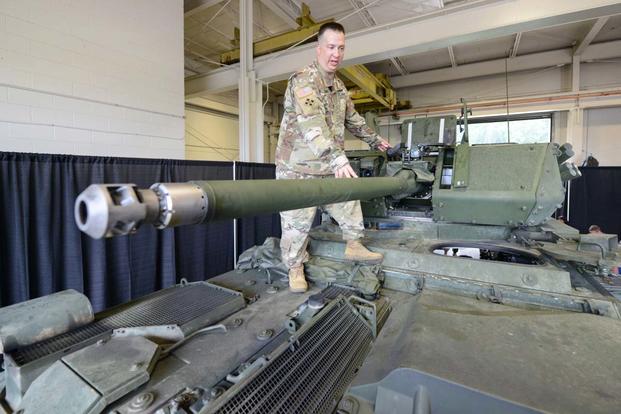ABERDEEN, Md. -- In direct response to a specific Russian threat, the Army's newly up-gunned and remodeled Stryker vehicles are headed to Europe with the first turret cannon fielded by the service since 120mm smoothbores were put on M1 Abrams tanks in 1986.
The first of the retrofitted, eight-wheeled M1126 Strykers mounted with a 30mm Kongsberg cannon is expected to arrive in Vilseck, Germany, in January to join the 4,800 troops and 330 combat vehicles of the 2nd Cavalry Regiment (2CR), said Col. Glenn Dean, Project Manager Stryker Brigade Combat Team.
At the same time, the Army will be delivering Strykers to the 2CR fitted with the Raytheon Common Remote Operations Weapon Station II, or CROWS II, which will enable a gunner to aim and fire the FGM-148 Javelin anti-tank missile while buttoned up inside the vehicle.
By the fall of 2018, the 2CR is expected to have 83 of the Strykers mounted with the .30mm cannon -- similar to the fearsome GAU-8/A Avenger Gatling .30mm nose cannon in the tank-killer A-10 Thunderbolt II ground attack aircraft, commonly known as the "Warthog."
Related content:
- WATCH: Soldiers Test-Fire New 30mm Cannon, Javelin Missile on Stryker
- Army to Test New Modular Turret on Stryker
- Military.com Equipment Guide: M1126 Stryker Combat Vehicle
However, Dean said the number of retrofitted Strykers eventually deployed to the 2CR will depend on how well the vehicles adapt to the tactics employed by the regiment.
"We're not going to put a .30mm cannon on every Stryker -- it's a selection of them," he said. "Part of the decision on how many for the future will depend on what 2nd Cavalry Regiment has to say on what works or what doesn't work, or if we have enough or too many."
Testing the Cannon
On Tuesday, the Army demonstrated the firepower of Strykers mounted with the .30mm cannon and the CROWS II Javelin-firing variant at a range at the Aberdeen Proving Ground in Maryland.
The Stryker with the magazine-fed cannon fixed on a target -- an old SUV -- about 1,100 meters downrange and riddled it with fire. First, there was single-shot fire, followed by rapid fire and then full-automatic bursts.
Related Video:
When the firing finished, Dean said, "This is the first new direct-fire weapons system and family of ammunition to enter the Army inventory since we put the 120mm cannon on the Abrams main battle tank."
Sgt. 1st Class Nicholas Young, a master gunner with the Stryker program, said the cannon is effective out to 3,000 meters and fed by two magazines, each carrying 78 rounds. Another 264 rounds could be stored in the hull, he added.
Young said the cannon will give Stryker crews "a huge advantage against the enemy that they don't have with the .50 'cal,' " a reference to the .50 caliber machine gun now mounted on many Stryker variants.
The .30mm can fire two types of rounds -- armor piercing and high explosive -- but Young stressed that the cannon is only an enhancement to the main purpose of the Strykers: to deliver a nine-man infantry squad to the fight.
"We're just giving them a bigger gun," Young said. "The purpose of the vehicle is to get those nine guys to the battlefield."
The Stryker's engine had to be upgraded from 350 horsepower to 450 horsepower to deal with the added weight of the turret, but the vehicle still gets about 5.5 miles per gallon and has a range of 320 miles on a full tank, depending on the terrain, Dean said.
Adding the Javelin
In the costly second part of the demonstration, a buttoned-up Styker carrying the CROWS II station hit a target about 1,500 meters downrange with the Javelin.
Each Javelin missile used to cost about $100,000, but now goes for about $150,000, Dean said.
Previously, in order to use the Javelin, the nine-man infantry squad carried by Strykers had to dismount out the back to set up the weapon on the ground, said Dean Barten, Product Director-Javelin at the Redstone Arsenal in Huntsville, Ala.
With the CROWS II station, the gunner inside the vehicle can fix on the target and fire the Javelin from a mount atop the vehicle.
"It's the same optics, the same sight systems," whether firing the "fire-and-forget" Javelin remotely or dismounted, Barten said.
"It's going to hit whatever you see," he said. The missile itself "sees the target before it even launches" with optics on the missile tube.
Firing the missile from atop the vehicle "gives you an extra 10 feet in line of sight," Barten said.
Situational Awareness
Following the firing demonstration, Maj. Gen. David Bassett, the Army's Program Executive Officer for Ground Combat Systems, acknowledged that the 2nd Cavalry Regiment will have to work out problems with "situational awareness" for the nine infantry troops carried by the Strykers mounted with the .30mm cannon and the two-man crew of driver and an assistant.
The sightlines from the rear top hatch from which the squad leader could pop up to scope out the terrain are blocked by the turret. To maintain situational awareness, the squad leader will now have to maintain contact with the driver or scrunch down into a small tunnel to see what the driver sees.
To work out the tactical kinks, the Army brought 10 troops from the 2nd Cavalry Regiment to Aberdeen to train on the retrofitted Strykers.
Because of the turret blocking the sight lines, "you're leaving that sole trust on the driver" to keep the squad informed, said Spc. Tyler Lowers, 20, of Wichita, Kansas, a member of 2CR's Third Squadron. "It's on you," he said of the driver.
Staff Sgt. Randall Engler, 27, of Novato, California, a squad leader in the Third Squadron, said, "The purpose of the truck is to get us to the fight. In essence, it helps us."
He said he expects that "we won't deviate at all" from current tactics.
"There's always a lot of cross talk" between the crew and the squad, and "I can see out the front if a need to" as the vehicle gets close to the drop zone, Engler said.
However, Lt. Col. Troy Meisel, deputy commander of the 2CR, said, "There's not a likelihood that this vehicle will lead the formation" into battle, but "it will allow us to get to the right place at the right time."
"It's not designed to attack a mechanized force," he said, "but it gives us more flexibility when we do come across them. It gives us the ability to survive those chance contacts" through the range of the .30mm cannon.
"You can throw a machine gun on a technical vehicle that had farther reach than our own .50 caliber did," Meisel said, but the test firings at Aberdeen "were engaging targets at 3,200 meters."
Russian Aggression
The development of the .30mm cannon for the Stryker is "directly attributable to Russian aggression" in Europe, he said.
During the Cold War, the U.S. had 300,000 troops stationed in Europe and now has 30,000. The problem for the Army is to make 30,000 look like 300,000, and the up-gunned Stryker "is one of the ways we can do that," Meisel said.
The evolution of the Stryker from the .50 caliber to the .30mm cannon fired from the remotely operated turret began in direct response to Russia's new BPM-97 armored personnel carrier mounted with a .30mm cannon that began showing up with the separatists in eastern Ukraine in January 2015.
In April 2015, the 2CR put out an "Urgent Operational Needs" statement calling on the Army to provide more lethality for the Strykers to match the threat posed by the BPM-97.
Last October, General Dynamics Land Systems Maneuver Collaboration Center in Sterling Heights, Michigan, delivered the first prototype called the ICVD, or Infantry Carrier Vehicle Dragoon -- "Dragoons" being the nickname of the 2CR.
At the event in Michigan, Gen. Dan Allyn, then the Army's Vice Chief of Staff, said the 30.mm cannon on the Stryker was one step in bolstering forces in Europe that were neglected during the wars in Iraq and Afghanistan.
Following the 2013 annexation of Crimea and the 2014 Russian backing of separatists in eastern Ukraine, Army leaders in Europe "identified a capability gap that threatened our forces in theater," Allyn said.
"The Russians, it turns out, had upgraded and fielded significant capabilities while we were engaged in Iraq and Afghanistan," he said. The prototype represented a "near-record time from concept to delivery."
At Aberdeen on Tuesday, Bassett and Dean said their teams were able to produce the new weapons systems by cutting down on design and remodeling existing equipment.
The remotely fired .30mm cannon was "nothing more than PowerPoints 18 months ago," Bassett said.
Creative Accounting
"One of the things that makes acquisition go faster is by picking things that don't require as much design," he said. "We took a mature turret chassis, we took an existing suspension system. What was left was the requirement to bring all those together."
It also took some creative accounting and lobbying of Congress to get the total $459 million for the ICVD and the CROWS II station, or about $3.8 million per vehicle, Dean said.
The Army in 2015 was able to wrangle about $10 million in reprogrammed money out of Congress to float the program and then avoid getting jammed up in the eventual Continuing Resolution fights on Capitol Hill over the defense budget, he said.
"That insulated us from the Continuing Resolutions," Dean said.
The first deployments of the Strykers with the .30mm cannon outside of Germany will likely be in Poland next year, he said.
Earlier this month in Germany, Col. Patrick Ellis, commander of the 2nd Cavalry Regiment, told The New York Times, "We know when we wake up every morning who the threat is. We're very focused on the Russian threat."
-- Richard Sisk can be reached at Richard.Sisk@Military.com.

























